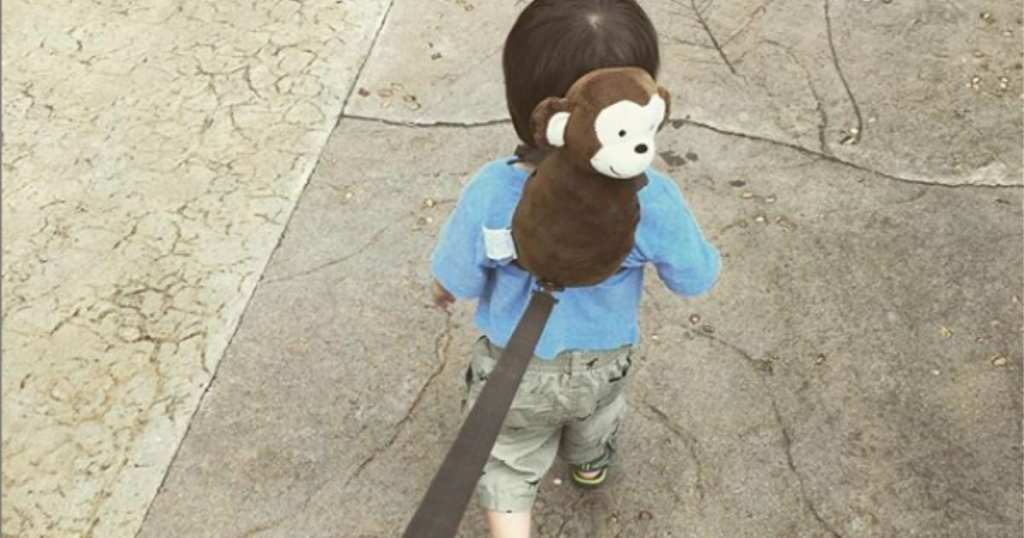There are more than a few things I said I would never do as a parent before I became one – and one of those things is putting a leash on my kid.
I mean, from the outside, it just looks sort of degrading, doesn’t it? Like you’re treating your precious baby like an animal? Or perhaps like you’re unable to keep track of your own child, like maybe you’re too busy looking at your phone to keep tabs?
Believe me, I had all of those thoughts as a non-parent, but now that I’m the proud owner of not one, but two toddlers, I can tell you two things for sure: they’re faster than you would believe, and the fear of losing them in public is bring-you-to-your-knees terrifying.
And hey – it turns out that using a leash might not warp them forever, either, according to child therapist Brooke Sprowl.
“As a child therapy expert, my sense is they don’t cause any real psychological harm and that our strong reactions to them are more about cultural norms than about any actual or lasting effects on the child’s psychology. Of the scarce research that has been conducted, none suggests that child leashes do cause physical or psychological harm.”
Basically, as with most things in life, children as blissfully unaware of how judgmental other people are…until the sad, inevitable day that they’re not.
“If it were culturally normative to leash children I don’t think anyone would have such a strong reaction to them and I can’t imagine children themselves expressing shame or humiliation about being leashed. If that were happening, we would know, and it would be a different story,” Sprowl adds.
She also thinks that for parents of children with special needs, or who have a bunch of kids, or parents who own that one little one who likes to sprint for freedom whenever he or she gets the chance, leashing can be a great and effective way to keep children safe.
Shelli Dry, a pediatric therapist, agrees – though she does have some additional thoughts.
“The first area to consider would be the purpose of the tether. Is it required for safety in an impulsive child or a child with special needs? When safety is a concern, it should take priority, however there are guidelines that should be followed.”
Janice Robinson-Celeste, chimed in with her agreement as well in an interview with Romper.
“As an early childhood specialist and a parent, I’ve used a ‘leash’ for one out of three of my own children because she was the one that could not be contained in one area. It is a safety precaution and is often necessary. I would rather her be on a safety harness than run into open traffic or off of a pier into the ocean. Many times these restraints help children who are perfecting walking to prevent terrible falls and head injuries. There were many times that I lifted my child mid-fall with these straps as if she was a marionette and prevented her from hitting her head on the pavement.”
The harnesses generally come in cute styles like animal backpacks or fairy wings, designs that young children would be excited to wear, and as long as no one acts like there’s something wrong with it, they’ll happily slip it on the next time you’re going to the zoo, a parade, a theme park, or somewhere else it can be stressful to think about not losing your child.
Dry reminds us to use them correctly, though, and to never pull or tug, or otherwise do something that “could lead to injury and harm to the child. The danger with wrist tethers are that the child could pull away sharply and injure their shoulder or arm. Safer alternatives to the wrist tether would be the harness backpacks or a walking handle in which the child learns to hold a loop or plastic handle.”
Also, Dry suggests using something like this, whether because of safety concerns, or for a child with special needs, or to assuage your own anxiety, as a teaching moment.
“Using a tether with a younger child should be a communication tool and teaching method to help children learn to stay beside their parent or caregiver,” says Dry. “The parent should express the loving desire to keep their child close by at all times. When the child learns to walk alongside the parent, than the use of the tether can be faded. In other words, use of a tether when used short term and in a loving manner as a teaching tool and for safety in a young child should not have a negative effect on the child.”
Here’s the thing: even though you know that you’re doing it for the right reasons and you’re sure you’re not harming your child, you might still get disapproving looks from perfect strangers.
Do what’s right for you and yours, and ignore the people who think they can pass judgment on someone they pass randomly in the street.
And welcome to parenthood…
